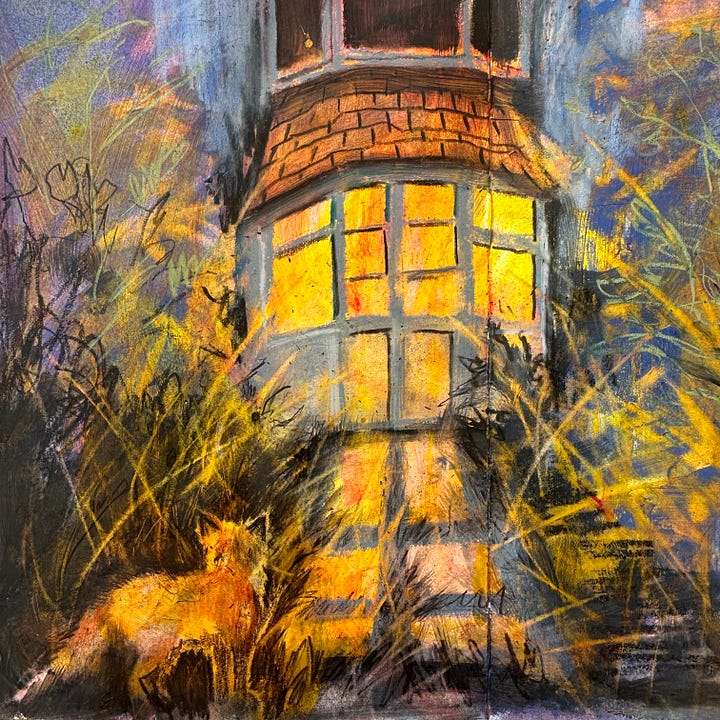Sketchbook Insights
Insights: Drawing every day in my sketchbook over the summer has led to some valuable, and sometimes unexpected, realisations. One of the first things I learned is that reducing the number of materials I use has significantly improved my focus and creativity. With the endless choices of tools, materials, and colours, it’s easy to feel overwhelmed. By limiting my tools, I've not only simplified the process but also found that my creativity flows more freely. AND the best bit - work seems to have more emotion to it - why is that? How does that work? Is it because with limited materials, each mark, colour, or texture you apply becomes more deliberate and meaningful?
Another key insight is the efficiency of pre-preparing sketchbook pages. Adding abstract swooshes of paint beforehand creates a canvas that invites serendipity, leading to more dynamic and unexpected sketches. I've also discovered that the Pith 200gsm sketchbook is perfect —it handles both wet and dry mediums with minimal bleed-through.
I’ve found that I’m developing a pretty confident visual language for water, trees, leaves, and grasses—basically, anything that moves in the wind. I’m also feeling at ease capturing figures and characters, especially those who aren’t too fussy about their likeness. But when it comes to buildings, well, let’s just say they don’t exactly spark joy. I suspect it’s because I haven’t drawn them enough to develop a visual language that really clicks. Right now, they feel stiff—yeah, I know buildings are supposed to be stiff, but mine seem to take it to a whole new level of rigidity, which feels at odds with my usual loose, flowing style. It’s literally like bashing up against a brick wall!
So, clearly, I need to dive deeper into this block and figure out how to bring a bit more life—and maybe a little less stiffness—to my architectural sketches. Because as much as I’d love to stick with my swaying trees, there’s a whole world of buildings out there that deserve a little more personality and could add so much more to the sense of place in my illustrations.


The most interesting insight I’ve had is that I feel like I’m skiving from work when I leave the studio to sketch somewhere else. The change of environment, stepping out of my usual space, creates a sense of detachment (from my to-do list). Once I find a spot and get into the flow of sketching, there’s a strange vortex of time and productivity that takes over. In that period, I don’t notice anything else—I’m totally focused, and I love that feeling.
One of the biggest challenges I encountered was overcoming the discomfort of sketching outside. It can feel like performance art when passersby take an interest, which can be daunting for someone with introverted tendencies. This insight requires a dedicated post as I’ve found a way to feel better about this. So watch this space. But for the time being one of my ways around it on more introverted days was to practice drawing from films, slowing them down to 20% speed so I can capture fleeting movements with equally fleeting marks. This exercise has been a fascinating way to engage with the fluidity of motion, allowing me to explore the dynamic relationship between movement and mark-making. Each mark carries its own weight and significance, contributing to the overall story of the piece. When I draw from slowed-down scenes, I’m able to focus on the subtleties of movement—the way a hand gestures, how fabric shifts, or the momentary tension in a figure’s posture.
BUT how do keep the energy and emotion when working up a piece into full colour?


Tips that might be useful:
-
Limit the materials you use
-
Find a sketchbook that works brilliantly with your favourite materials
-
Pre-prepare sketchbook pages
-
Notice “what” gets you into flow-state
-
Address the barriers you face with a curious mindset
-
If drawing outside is too much right now, draw from a film playing at slow-mo
I embarked on this sketch everyday personal challenge to prepare for the first semester of my MA at Cambridge, where observational drawing will be a significant focus. By drawing every day, I feel better equipped to hit the ground running when the semester begins. I’ll still be nervous though!
One Idea for You to Consider:
What small thing can you do everyday for 30 days that would prepare you for something amazing in the future?
September’s shenanigans:
-
Inky Postcard Sunday Club starts at Rosado Lounge in Tewkesbury
-
Mini Moo workshop with Gloucestershire Deaf Association
-
A guided photo-walk hosted by Tewkesbury Alleycats with local historian Steve and I’ll be on hand to assist keen photographers
-
Illustration Degree Graduation Day at Worcester Cathedral and a catch-up with all my fellow illustrator graduates
-
The “MA Children's Book Illustration” starts in Cambridge
-
Visit to Cumbria for “How to paint your dog” and “How to paint a charcoal Hare”
-
“How to paint your dog” workshop in Tewkesbury


Inspiration “Everyone must take time to sit and watch the leaves change”
- Elizabeth Lawrence






Leave a comment